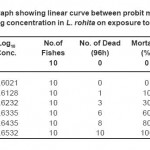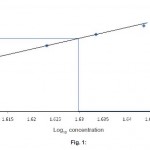Acute Toxicity and Behavioural Responses of Labeo rohita (Hamilton) to a Biopesticide “NEEM-ON”
Imtiyaz Ahmad Bhat1 * , Bilal Ahmad Bhat1 , Santsoh Vishwakarma1 , Alok Verma2 and Geeta Saxena1
1
Department of Zoology,
Government Science and Commerce College Benazir,
Bhopal,
462008
India
2
Department of Zoology,
Government College Lateri,
Vidisha,
464114
India
DOI: http://dx.doi.org/10.12944/CWE.7.1.26
The objective of this study was to determine the toxicity of the neem biopesticide azadirachtin (NEEM-ON, Brand name) on the freshwater fish ‘Labeo rohita’. Fishes were exposed to various concentrations of botanical insecticide azadirachtin for 96 h and the percent mortality was recorded. The 96h LC50 value determined by Finney’s Probit Analysis Method was found to be 42.66 ppm. Behavioural patterns were observed critically during the whole experiment. The test fish exhibited erratic swimming, increased surfacing, decreased rate of opercular movement, reduced agility and inability to maintain normal posture and balance with increasing exposure time.
Copy the following to cite this article:
Bhat IA, Bhat BA, Vishwakarma S, Verma A, Saxena G. Acute Toxicity and Behavioural Responses of Labeo rohita (Hamilton) to a Biopesticide “NEEM-ON”. Curr world Environ 2012;7(1):175-178 DOI:http://dx.doi.org/10.12944/CWE.7.1.26
Copy the following to cite this URL:
Bhat IA, Bhat BA, Vishwakarma S, Verma A, Saxena G. Acute Toxicity and Behavioural Responses of Labeo rohita (Hamilton) to a Biopesticide “NEEM-ON”. Curr world Environ 2012;7(1):175-178. Available from: http://www.cwejournal.org/?p=2079
Download article (pdf)
Citation Manager
Publish History
Select type of program for download
| Endnote EndNote format (Mac & Win) | |
| Reference Manager Ris format (Win only) | |
| Procite Ris format (Win only) | |
| Medlars Format | |
| RefWorks Format RefWorks format (Mac & Win) | |
| BibTex Format BibTex format (Mac & Win) |
Article Publishing History
| Received: | 2012-01-01 |
|---|---|
| Accepted: | 2012-02-27 |
Introduction
Neem (Azadirachtin indica) is a traditional and highly esteemed medicinal tree for the people of Indian sub-continent.It is one of the most promising medicinal plant, having a wide spectrum of biological activity, well known for its insecticidal properties (ICAR, 1993). Biological activities and medicinal properties of neem have been extensively reviewed by Biswas et al (2002). Azadirachtin (a tetranotriterpenoid) is one of the major components (Kraus et al., 1981; Broughton et al., 1986) of neem, which have pesticide property. In view of the environmental problems caused by the use of synthetic chemicals and the growing need for alternative methods of pest control that minimize this damage, there has been extensive research on pest control by substances from plants. One of the most promising natural compounds is azadirachtin, an active compound extracted from the neem tree. Recently neem based pesticides are popularised due to their effectiveness, cheaper price and comparatively safe for users, which is used widely in several states of India. However, neem has been found to be toxic to non-target organisms where it induces marked alterations in experimental animals (Mahboob et al., 1998; Anjaneyulu et al., 1999; Mondal et al., 2007).
Fishes are considered as good indicators of aquatic pollution. They are highly sensitive to the alterations in the quality of water. Labeo rohita was selected as the test species. The present study was aimed to determine the 96h LC50 value and behavioural response of a neem based pesticide “NEEM-ON” to the freshwater fish Labeo rohita.
Material and Methods
Biopesticide
NEEM-ON (Manufactured by Jai Kissan Agro Pvt. Ltd., Sangam nagar, Indore, M.P.) was used in this study. It is based on neem seed kernel extract containing a minimum of 0.15% EC (1500PPM) of azadirachtin as active ingredient.
Test animal
Labeo rohita weighing 58±3g and average length of 15cm were collected from the Patra Fish Farm, Berkhedi, Bhopal, Madhya pradesh. The fishes were acclimatized to the laboratory conditions for 15 days. They were fed daily with commercial fish pellets.Water was renewed after every 24hrs. Physio-chemical characteristics of water were determined and maintained.
Experimental procedure
The experiments were conducted in a series of glass aquariums (30 litre capacities) filled with 20 litre tap water. The stock solution was prepared and the required quantity of azadirachtin was drawn from this stock solution to find out the LC50 value for 96 h. Different concentrations were prepared and for each concentration a control was maintained. Ten acclimatized fishes of uniform size were exposed to each concentration. Preliminary tests were carried out to find out the median lethal concentration (LC50) of the fish to azadirachtin for 96h by Fenney’s Probit Analysis Method. The control and the exposed fish were aerated frequently to prevent hypoxic condition of the medium. The control and azadirachtin exposed fish were kept under continuous observation during the experiment period. Feeding to fishes was stopped during the experiment. Behaviour of the test fishes was observed and the dead fishes were removed and recorded from time to time during 96 hr exposure period. The water in the containers was changed every 24 hr and a constant concentration of Neem-on was maintained during the period of exposure.
Results
The maximum concentration at which zero percent mortality and minimum concentration at which 100% mortality of Labeo rohita were observed was at 40 ppm and 45ppm respectively. The determination of 96h LC50 value of Neem-on to Labeo rohita was found to be 42.66ppm by Finney’s Probit Analysis Method (1971) and is depicted in the graph.
In this study, Labeo rohita was subjected to various concentrations of Neem-on and its behavioral changes were observed. The behavioral and the swimming patterns of the fish were normal in case of control group and there was no mortality. After the exposure of fishes to Neem-on, various behavioral changes were observed. First the schooling of fishes starts disrupting and then abnormal swimming behavior increases. The fishes were observed to hit the aquarium walls. The opercular movement initially increases and then decreases with rising toxicant concentration in the exposed fishes. Vertical and downward swimming patterns were observed. Loss of balance increased and the color of the fish were observed to get lighter with an increased secretion of mucus. Surfacing frequency and gulping of surface water with occasional coughing increases remarkably in exposed fishes. Defecation was increased and more fecal matter was found at the bottom of the aquarium than control. Finally due to complete loss of balance, fishes sank to bottom with their ventral side facing upwards. After 96h exposure of pesticide to fishes, at 45ppm hundred percent mortality was observed.
 |
Table 1: The graph showing linear curve between probit mortality of fish against log concentration in L. rohita on exposure to Neem-on. Click here to View table |
 |
Figure 1: Click here to View figure |
Discussion
The acute toxicity values of several neem products for different fish species have been reported earlier by many workers. Das et al., 2002 have studied the acute toxicity of neem in the fingerlings of Indian major carps i.e., Labeo rohita, Catla catla and Cirrhinus mrigala and the 96h LC50 values were found to be 2.36, 2.04 and 2.78ppm respectively. Hassanein et al., 2007 reported the 96h LC50 value of a neem biopesticide (Triology) on the grass carp fish, Ctenopharyngodon idella and was found to be 112ppm. In the present study, the 96h LC50 value of Neem-on on the Labeo rohita was found to be 42.66ppm. The variation in the LC50 values is due to its dependence upon various factors viz., sensitivity to the toxicant, its concentration and duration of exposure; type and size of the test animal and so on.
Behavioral changes are the most sensitive indication of potential toxic effects. Impact of different pesticides on the behavior of Labeo rohita have been studied by various workers (Marigoudar et al., 2009; Anita et al., 2010; Nagaraju et al., 2011).
Fishes exhibited a number of behavioral changes when they were exposed to different concentrations. The opercular movement of fishes initially increases and then gradually decreases. Decreased opercular movement probably helps in reducing absorption of pesticide through gills. Abnormal swimming and loss of balance was caused by the decifiency in nervous and muscular coordination which may be due accumulation of acetylcholine in synaptic and neuromuscular junctions (Rao et al., 2005). A thick coat of mucus was observed all over the body of the fish, making the fish slimier. The fish were swimming with the belly upwards and in zig zag motion. There were also erratic and parallel movements observed in the fish, indicating loss of equilibrium while in control, the fish was swimming normally without loss of equilibrium. The fish sometimes becomes highly excited and was observed to hit the aquarium walls at a very fast speed. Due to this hyperexcitibility bleeding from the snout was observed in some fishes.
Neem-on, a biopesticide is an ecofriendly product used against different pest species but its effect on non-target organisms can not be ruled out. So, neem based pesticides should be used cautiously.
References
- ICAR: World Neem Conference Souvenir ICAR, Bangalore, India (1993).
- Biswas, K., Chattopadhyay, I., Banerjee, R. and Bandyopadhyay, U. Biological activities and medicinal properties of neem (Azadirachta indica). Current Science, 82: 1336-1345 (2002).
- Kraus, R.K., R.Cramer and G.Sawitzki. Tetranortriterpenoids from the seeds of Azadirachtin indica. Phytochemistry, 20(1): 117 (1981).
- Broughton, H.B., S.V.Ley, A.M.Z. Slawin, J.D. Williams and E.D.Morgan: X-ray crystalographic structure determination of detigloyldihydroazadirachtin and reassignment of the structure of the limionoid insect antifeedent azadirachtin .J.Chem.Soc. Chem. Commun., 391-401(1986).
- Mahboob, M., J. Siddiqui and K. Jamil: The effect of subacute administration of a neem pesticide on rat metabolic enzymes. J. Environ. Sci. Hlth., 33: 425–438 (1998).
- Anjaneyulu, G.V.S.R. and K.D.Mishra. Acute toxicity of Neemax (Neem Seed Powder) to a freshwater fish, Puntius ticto Ham. Pollution Research . 18(4): 391-394 (1999).
- Mondal, D.; Barat, S. and Mukhopadhyay, M. K.: Toxicity of neem pesticides on a fresh water loach Lepidocephalichthys guntea (Ham.) of Darjeeling district in west Bengal. J. Environ. Biol. 28(1): 119-122 (2007).
- Finney, D.J.: Probit Analysis, 3rd Edn. Cambridge University Press, London (1971).
- Das, B. K., Mukherjee, S. C., and Murjani, O. Acute toxicity of neem (Azadirachta indica) in Indian major carps. Journal of Aquaculture in the Tropics, 17: 23-33 (2002).
- Hassanein, H. M. A; Okail, H. A. and Mohamed, N.K. Biochemical changes in proteins and DNA in Ctenopharyngodon idella due to environmental pollution with the biopesticide (Trilogy). 10 ICCA, Garyounis University, Benghazi, Libya: 18-21 (2007).
- Marigoudar S.R., R.Nazeer Ahmed and M.David. Impact of Cypermethrin on behavioural responses in the freshwater teleost, Labeo rohita (Ham.). World Journal of Zoology. 4(1): 19-23, (2009).
- Anita S, K.Sobha and K.S.Tilak. A study on acute toxicity, oxygen consumption and behavioural changes in the three major carps, Labeo rohita, Catla catla and Cirrhinus mrigala exposed to Fenvalerate. Bioresearch Bulletin. 33-40 (2010).
- Nagaraju B, Sudhakar P, Anitha A, Haribabu G and Rathnamma V.V.: Toxicity evaluation and behavioural studies of freshwater fish Labeo rohita exposed to Rimon. International Journal of Research in Pharmaceutical and Biomedical sciences. ISSN., 2229-3701 (2011).
- Rao, J.V., G.Begum, G. Pallela, P.K.Usman and R.N.Rao. Changes in behavior and brain acetylcholinesterase activity in mosquito fish Gambusia affinis in relation to sublethal exposure of chlorpyrifos. Int. J. Environ. Res. Public Health, 2(3-4): 478-483 (2005).






